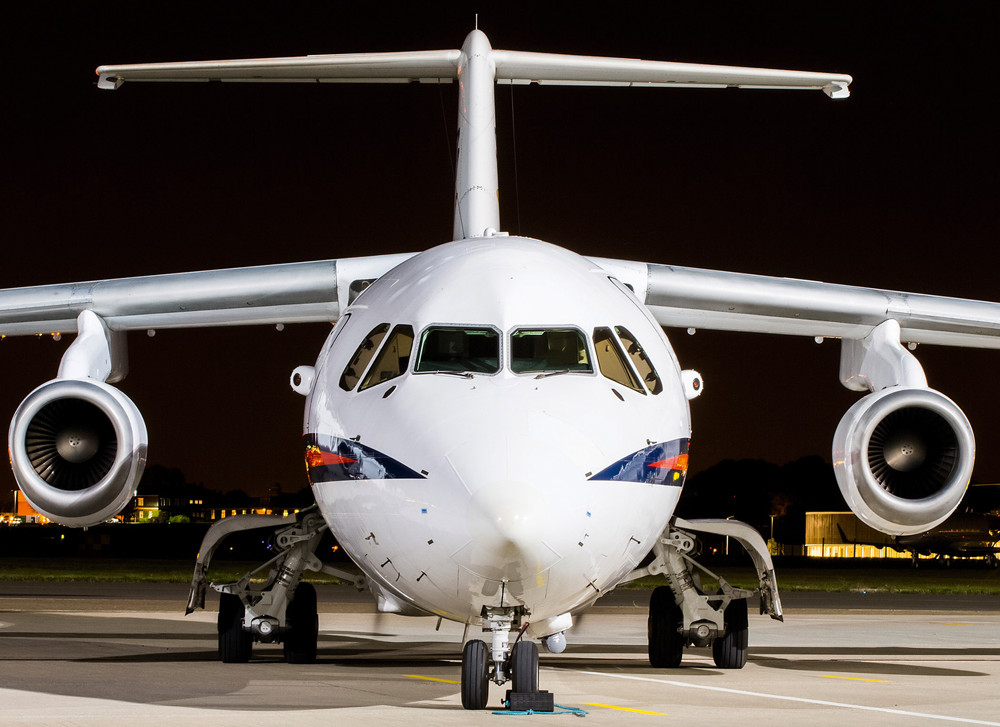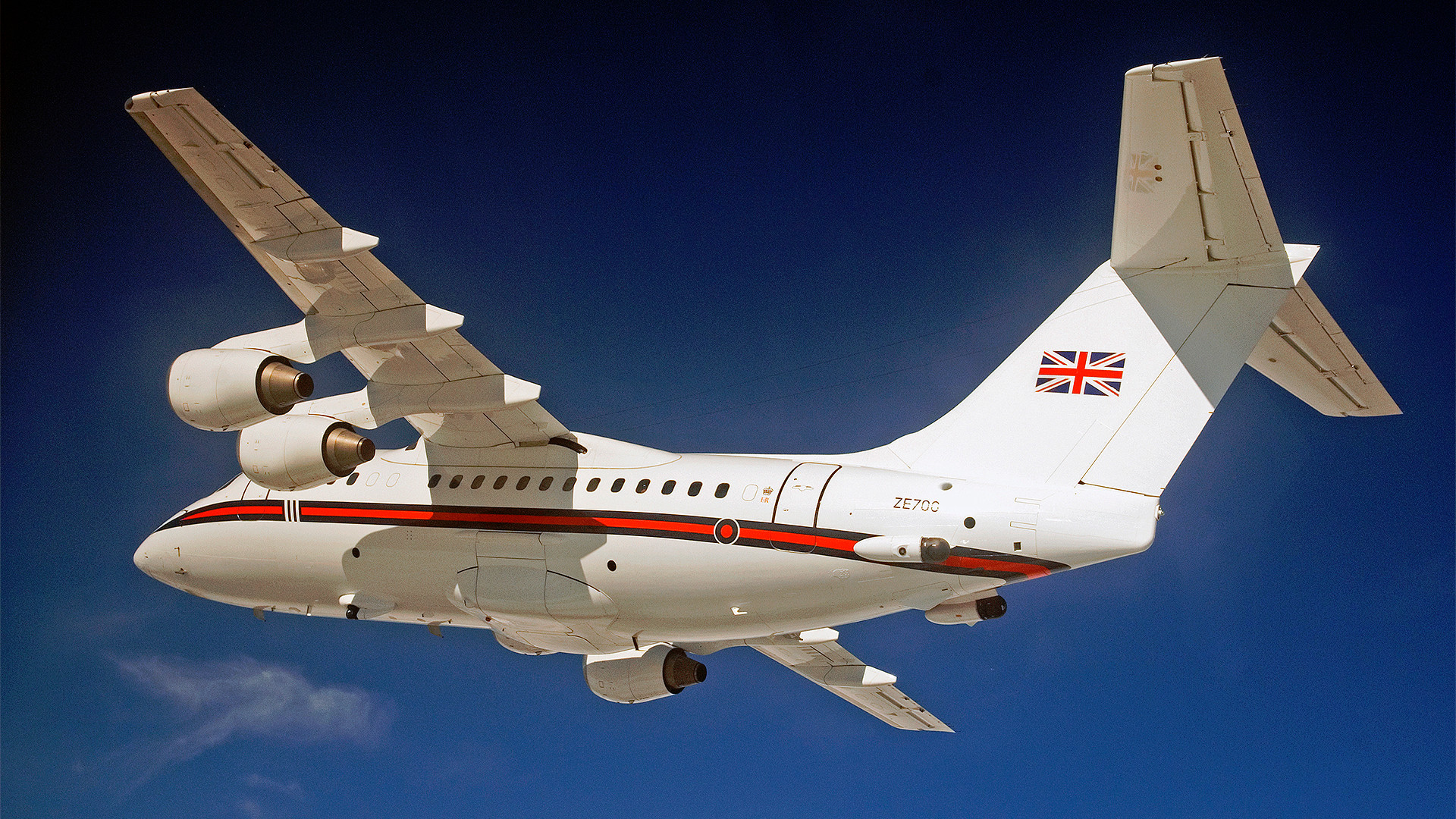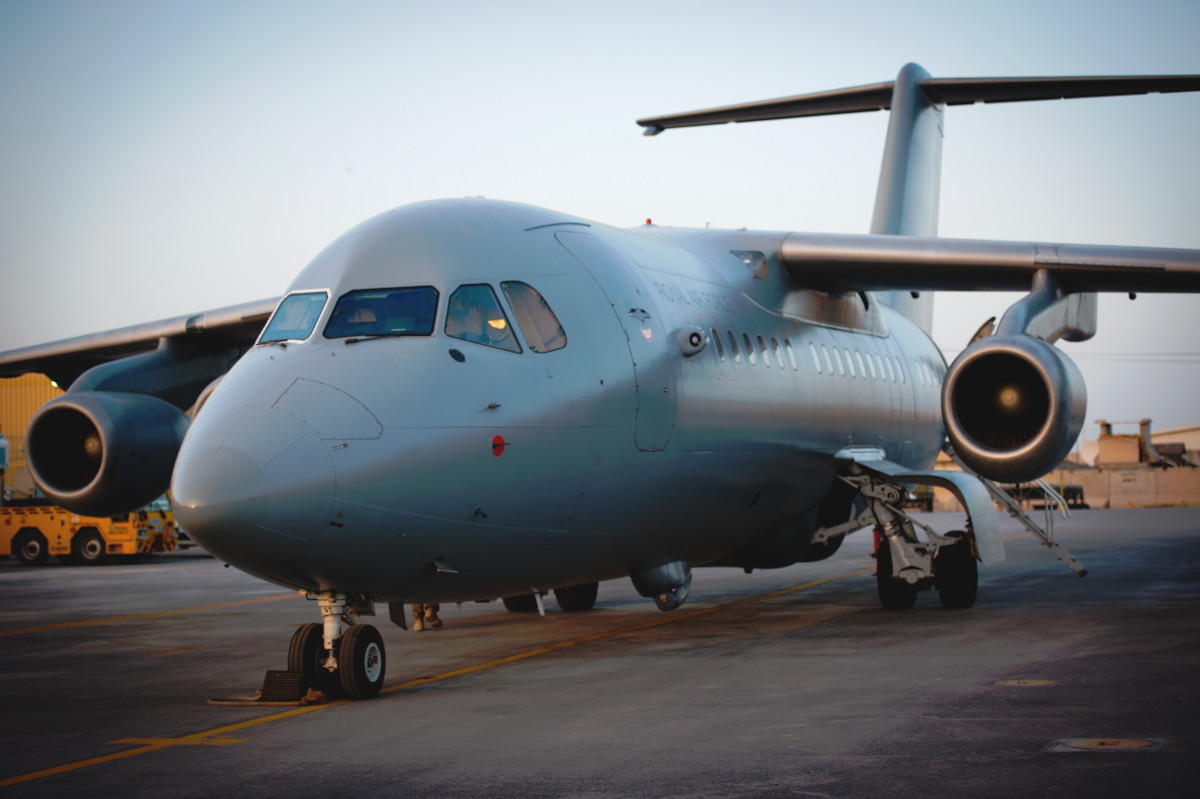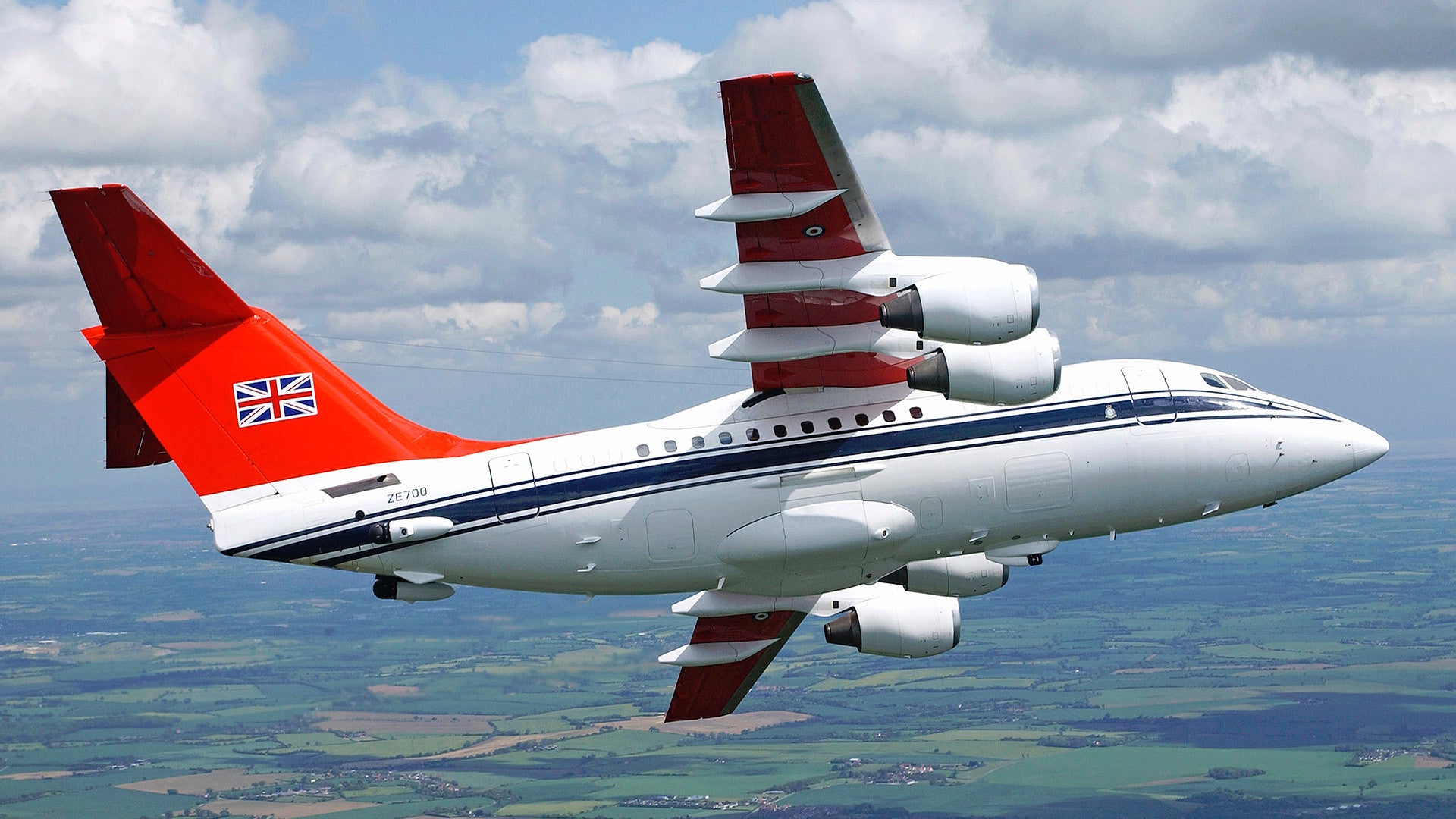The U.K. Royal Air Force is looking to sell off its four BAe 146 jet transports. Two of these are presently configured specifically for VIP missions, including flying around members of the country’s Royal Family, as well as senior government and military officials, while the remaining pair are set up as small airlifters. Over the years, the four-engine jet aircraft, which have excellent short takeoff and landing capabilities and rough field performance, have flown missions in Afghanistan, Iraq, and Libya.
Jane’s 360
was first to report on potential sale after noticing the U.K.’s Defense Equipment Sales Authority (DESA) had included the aircraft in a brochure at the biennial Defence and Security Equipment International (DSEI), which opened on Sept. 10, 2019, and closes today. The RAF’s No. 32 Squadron, “The Royal,” operates both the VIP versions, known to the service as BAe 146 CC.2s, as well as the BAe 146 C.3 transport variants.
It is “too early in the process to be discussing out-of-service dates and replacements [for the BAe 146s],” an unnamed U.K. Ministry of Defense source told Jane’s. DESA included of the planes in their brochure for purposes of “testing the market’s appetite for a potential sale in the future,” they added.
In recent years, the RAF has looked to divest a number of aircraft, including C-130J Hercules and its R.1 Sentinel intelligence, surveillance, and reconnaissance aircraft, as part of efforts to draw down and consolidate its forces after the United Kingdom’s withdrawal from Iraq in 2011 and Afghanistan in 2014. There could certainly be interest from both commercial and military buyers in the four-engine jets if they were to come up for sale.

Developed in the 1970s by Hawker Siddeley and then British Aerospace (BAe), the BAe 146 was primarily intended to be a small regional airliner that could operate from relatively small airports and fly quietly so as to be less disruptive to communities below. The planes had impressive short takeoff and landing capabilities and good performance from unimproved runways, even being able to operate from roads.

Marketed for a time as the Whisperjet, those same features gave it clear potential as a military aircraft, as well. BAe proposed airlifter, aerial refueling tanker, and carrier onboard delivery versions. The company even built a demonstrator of a Sideloading Tactical Airlifter (STA) variant with a mock aerial refueling probe over the cockpit, which was based on a commercial cargo version called the Quiet Trader.

Despite these proposals, purchase orders for BAe 146s came almost exclusively from commercial operators. This continued when production shifted to the Avro RJ-series variants, beginning in 1993. The RJ-series aircraft replaced the BAe 146’s Avco Lycoming ALF 502 with improved LF 507 models featuring a digital control system, as well as new digital avionics. British Aerospace produced a total of 221 BAe 146s of all types, while Avro, and later BAE Systems, built 166 RJ-series versions.
In 1983, however, the RAF had leased two BAe 146s, which they referred to as CC.1s, to evaluate them as a possible replacement for the aging Hawker Siddeley Andover twin-engine turboprops that the Queen’s Flight used to support the Royal Family. The following year, the service purchased the two CC.2 variants for this role. A third example arrived at the Queen’s Flight in 1989, but was sold in 2002.
For its VIP mission, the BAe 146 offered dramatic improvements over the older Andovers, being able to fly 60 percent further than the 1960s-era turboprops, as well as carry more passengers in greater comfort. Standard airliner variants of the aircraft can carry between 70 and 112 passengers, but with their more luxurious, business jet-like interiors, the CC.2s can accommodate 19 passengers, in addition to the crew of six.

In 1995, the RAF combined the Queen’s Flight with No. 32 Squadron, which also had a VIP transport role. As part of the process, it also eliminated its practice of having aircraft dedicated to supporting the Royal Family and began operating the CC.2s in a broader VIP and light airlift capacity. In these roles, the aircraft supported British operations in Iraq intermittently between 2003 and 2011 and also took part in the NATO-led intervention in Libya in 2011.
The RAF purchased another two BAe 146s second hand from TNT Airways, a Belgian freight airline, in 2012. These were so-called “Quick Change” or QC versions with interiors that could be rapidly reconfigured to accommodate passengers, cargo, or a mix of both. These variants also have a large rear cargo door for relatively easy loading and unloading of palletized cargo, a feature carried over from the original Quiet Trader and STA variants.

Hawker Beechcraft, under contract to BAE Systems, modified these planes into the C.3 configuration and delivered them to No. 32 Squadron in 2013. The conversion process included the addition of various self-defense features, including decoy flare dispensers and a directional infrared countermeasures systems, or DIRCM. DIRCM systems typically use a suite of sensors to spot and track incoming infrared homing missiles, and then use turreted lasers to blind or confuse the seekers on those weapons.
The CC.2s had already gained a DIRCM suite from Northrop Grumman in the 1990s, which then evolved in the following years. The original installation was a system that included two turreted lasers mounted on the rear fuselage. The two aircraft eventually gained a sponson with a third, improved turret under the forward fuselage.
Eventually, Northrop Grumman provided the latest generation of its AN/AAQ-24 Large Aircraft Infrared Countermeasure (LAIRCM) system to replace the turrets in all three positions. This is the same configuration found on the C.3s at present, as well.

“The 146’s defensive aids suite (DAS) also offers government ministers and high-ranking military leaders protection during visits overseas where a risk to security is perceived,” according to the RAF’s own official page on the aircraft. DIRCM is particularly valuable for defeating shoulder-fired heat-seeking missiles, also known as man-portable air defense systems, or MANPADS. The aircraft’s four engines, rare for a plane this size, also offers valuable redundancy in case one of the turbofans fails for any reason.
The C.3s supported British operations in Afghanistan, which finally came to a close in 2014. Since then, the CC.2s and C.3s have continued to be available for VIP and light airlift duties anywhere the U.K. armed forces may be operating. The plane’s short takeoff and landing and rough field capabilities have already proven their worth in combat zones.

The BAe 146 continues to be popular with airlines and freight services, including those that operate in more austere locations. A number of examples are in service commercially as water bombers for forest fire fighting operations, as well. As noted, if the RAF decides to go ahead with the sale of the jets, they could easily find their way to civilian operators.

Still, given the present configuration of the CC.2s and C.3s, especially defensive features, they could be very attractive to military operators, too. Back in 2009, BAE Systems had offered an upgrade package for second-hand BAe 146s and RJ-series aircraft, known as the BAe 146M, that included a new glass cockpit, defensive systems, and additional fuel tanks for extra range. The defense contractor said it could configure these aircraft for airlift missions, as well as for intelligence, surveillance, and reconnaissance and aerial refueling tanker roles.

The aircraft’s nascent quiet operation and its general airliner appearance could also make it ideal for support discreet operations, including those by special operations forces. The U.S. Air Force Special Operations Command (AFSOC), for instance, notably flies a fleet of C-146A Wolfhounds, a militarized version of the Dornier Do 328 twin-engine turboprop light transport, in civilian style paint schemes, for exactly these sorts of missions. AFSOC also has other, smaller civilian-styled planes it hard originally acquired for this role, but has increasingly shifted them to intelligence, surveillance, and reconnaissance and advisory missions.
Depending on what state the RAF offers the CC.2s and C.3s in, it is also possible that private individual could purchase one or more of them. The VIP-configured CC.2s would offer greater capacity than many business jets, but without having to pay the operating costs associated with full-size airliners. The BAe 146’s operational capabilities would also open up a greater number of airports and airfields to fly to and from, including smaller private airstrips.
There’s no word yet on when the four planes might officially hit the market or what the price point will be. The total costs associated with purchasing and modifying the two BAe 146s into the C.3 configuration in 2012 was nearly $73 million, or more than $80 million in 2019 dollars. However, the RAF has been selling off relatively low-mileage C-130Js at a fraction of the cost of a new example.
We will have to wait and see when, and in what state, the RAF’s BAe 146s actually come up for sale, but it seems very likely that they will get another lease on life with a new operator, either in the commercial or military realm.

Contact the author: joe@thedrive.com
